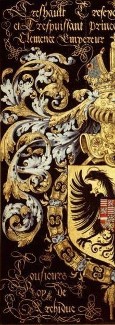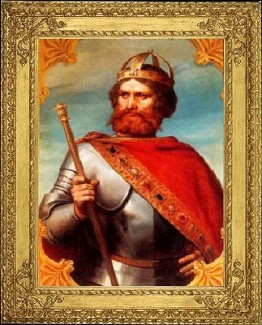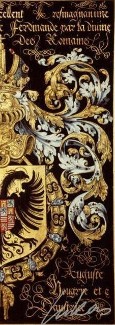


Holy Roman Emperor Frederick I - 1155-1190
Frederick I (German: Friedrich; 1122 – 10 June 1190), also known as Frederick Barbarossa, was the Holy Roman Emperor from 1155 until his death. He was elected King of Germany at Frankfurt on 4 March 1152 and crowned in Aachen on 9 March 1152. He became King of Italy in 1155 and was crowned Roman Emperor by Pope Adrian IV on 18 June 1155. Two years later, the term sacrum ("holy") first appeared in a document in connection with his Empire. He was later formally crowned King of Burgundy, at Arles on 30 June 1178. He got the name Barbarossa from the northern Italian cities he attempted to rule: Barbarossa means "red beard" in Italian; in German, he was known as Kaiser Rotbart, which has the same meaning.
Before his imperial election, Frederick was by inheritance Duke of Swabia (1147–1152, as Frederick III). He was the son of Duke Frederick II of the Hohenstaufen dynasty and Judith, daughter of Henry IX, Duke of Bavaria, from the rival House of Welf. Frederick therefore descended from the two leading families in Germany, making him an acceptable choice for the Empire's prince-electors.
Historians consider him among the Holy Roman Empire's greatest medieval emperors. He combined qualities that made him appear almost superhuman to his contemporaries: his longevity, his ambition, his extraordinary skills at organization, his battlefield acumen and his political perspicuity. Among his contributions to Central European society and culture include the reestablishment of the Corpus Juris Civilis, or the Roman rule of law, which counterbalanced the papal power that dominated the German states since the conclusion of the Investiture Controversy.
Life and reign - Early years
Frederick was born in 1122. In 1147 he became Duke of the southern German region of Swabia (Herzog von Schwaben), and shortly afterwards made his first trip to the East, accompanied by his uncle, the German king Conrad III, on the Second Crusade. The expedition proved to be a disaster, but Frederick distinguished himself and won the complete confidence of the king. When Conrad died in February 1152, only Frederick and the prince-bishop of Bamberg were at his deathbed. Both asserted afterwards that Conrad had, in full possession of his mental powers, handed the royal insignia to Frederick and indicated that Frederick, rather than Conrad's own six-year-old son, the future Frederick IV, Duke of Swabia, succeed him as king. Frederick energetically pursued the crown and at Frankfurt on 4 March 1152 the kingdom's princely electors designated him as the next German king. He was crowned King of the Romans at Aachen several days later, on 9 March 1152. Frederick's father was from the Hohenstaufen family, and his mother was from the Welf family, the two most powerful families in Germany. The Hohenstaufens were often called Ghibellines, which derives from the Italianized name for Waiblingen castle, the family seat in Swabia; the Welfs, in a similar Italianization, were called Guelfs.
The reigns of Henry IV and Henry V left the status of the German empire in disarray, its power waning under the weight of the Investiture controversy. For a quarter of a century following the death of Henry V in 1125, the German monarchy was largely a nominal title with no real power. The king was chosen by the princes, was given no resources outside those of his own duchy, and he was prevented from exercising any real authority or leadership in the realm. The royal title was furthermore passed from one family to another to preclude the development of any dynastic interest in the German crown. When Frederick I of Hohenstaufen was chosen as king in 1152, royal power had been in effective abeyance for over twenty-five years, and to a considerable degree for more than eighty years. The only real claim to wealth lay in the rich cities of northern Italy, which were still within the nominal control of the German king. The Salian line had died out with the death of Henry V in 1125. The German princes refused to give the crown to his nephew, the duke of Swabia, for fear he would try to regain the imperial power held by Henry V. Instead, they chose Lothair III (1125–1137), who found himself embroiled in a long-running dispute with the Hohenstaufens, and who married into the Welfs. One of the Hohenstaufens gained the throne as Conrad III of Germany (1137–1152). When Frederick Barbarossa succeeded his uncle in 1152, there seemed to be excellent prospects for ending the feud, since he was a Welf on his mother's side. The Welf duke of Saxony, Henry the Lion, would not be appeased, however, remaining an implacable enemy of the Hohenstaufen monarchy. Barbarossa had the duchies of Swabia and Franconia, the force of his own personality, and very little else to construct an empire.
The Germany that Frederick tried to unite was a patchwork of more than 1600 individual states, each with its own prince. A few of these, such as Bavaria and Saxony, were large. Many were too small to pinpoint on a map. The titles afforded to the German king were "Caesar", "Augustus", and "Emperor of the Romans". By the time Frederick would assume these, they were little more than propaganda slogans with little other meaning. Frederick was a pragmatist who dealt with the princes by finding a mutual self-interest. Unlike Henry II of England, Frederick did not attempt to end medieval feudalism, but rather tried to restore it, though this was beyond his ability. The great players in the German civil war had been the Pope, Emperor, Ghibellines, and the Guelfs, but none of these had emerged as the winner.
Rise to power
Eager to restore the Empire to the position it had occupied under Charlemagne and Otto I the Great, the new king saw clearly that the restoration of order in Germany was a necessary preliminary to the enforcement of the imperial rights in Italy. Issuing a general order for peace, he made lavish concessions to the nobles. Abroad, Frederick intervened in the Danish civil war between Svend III and Valdemar I of Denmark and began negotiations with the Eastern Roman Emperor, Manuel I Comnenus. It was probably about this time that the king obtained papal assent for the annulment of his childless marriage with Adelheid of Vohburg, on the grounds of consanguinity (his great-great-grandfather was a brother of Adela's great-great-great-grandmother, making them fourth cousins, once removed). He then made a vain effort to obtain a bride from the court of Constantinople. On his accession Frederick had communicated the news of his election to Pope Eugene III, but had neglected to ask for the papal confirmation. In March 1153, Frederick concluded the treaty of Constance with the Pope, whereby he promised, in return for his coronation, to defend the papacy, to make no peace with king Roger II of Sicily or other enemies of the Church without the consent of Eugene, and to help Eugene regain control of the city of Rome.
First Italian Campaign: 1154–55
Frederick undertook six expeditions into Italy. In the first, beginning in October 1154, his plan was to launch a campaign against the Normans under King William I of Sicily. He marched down and almost immediately encountered resistance to his authority. Obtaining the submission of Milan, he successfully besieged Tortona in early 1155, razing it to the ground. He moved on to Pavia, where he received the Iron Crown and the title of King of Italy. Moving through Bologna and Tuscany, he was soon approaching the city of Rome. There, Pope Adrian IV was struggling with the forces of the republican city commune led by Arnold of Brescia, a student of Abelard. As a sign of good faith, Frederick dismissed the ambassadors from the revived Roman Senate, and Imperial forces suppressed the republicans. Arnold was captured and hanged for treason and rebellion. Despite his unorthodox teaching concerning theology, Arnold was not charged with heresy.
As Frederick approached the gates of Rome, the Pope advanced to meet him. At the royal tent the king received him, and after kissing the pope's feet, Frederick expected to receive the traditional kiss of peace. Frederick had declined to hold the Pope's stirrup while leading him to the tent, however, so Adrian refused to give the kiss until this protocol had been complied with. Frederick hesitated, and Adrian IV withdrew; after a day's negotiation, Frederick agreed to perform the required ritual, reportedly muttering, "Pro Petro, non Adriano -- For Peter, not for Adrian." Rome was still in an uproar over the fate of Arnold of Brescia, so rather than marching through the streets of Rome, Frederick and Adrian retired to the Vatican.
The next day, 18 June 1155, Adrian IV crowned Frederick I Holy Roman Emperor at St Peter's Basilica, amidst the acclamations of the German army. The Romans began to riot, and Frederick spent his coronation day putting down the revolt, resulting in the deaths of over 1,000 Romans and many more thousands injured. The next day, Frederick, Adrian, and the German army travelled to Tivoli. From there, a combination of the unhealthy Italian summer and the effects of his year-long absence from Germany meant he was forced to put off his planned campaign against the Normans of Sicily. On their way northwards, they attacked Spoleto and encountered the ambassadors of Manuel I Comnenus, who showered Frederick with costly gifts. At Verona, Frederick declared his fury with the rebellious Milanese before finally returning to Germany.
Disorder was again rampant in Germany, especially in Bavaria, but general peace was restored by Frederick's vigorous, but conciliatory, measures. The duchy of Bavaria was transferred from Henry II Jasomirgott, margrave of Austria, to Frederick's formidable younger cousin Henry the Lion, Duke of Saxony, of the House of Guelph, whose father had previously held both duchies. Henry II Jasomirgott was named Duke of Austria in compensation for his loss of Bavaria. As part of his general policy of concessions of formal power to the German princes and ending the civil wars within the kingdom, Frederick further appeased Henry by issuing him with the Privilegium Minus, granting him unprecedented entitlements as Duke of Austria. This was a large concession on the part of Frederick, who realized that Henry the Lion had to be accommodated, even to the point of sharing some power with him. Frederick could not afford to make an outright enemy of Henry.
On 9 June 1156 at Würzburg, Frederick married Beatrice of Burgundy, daughter and heiress of Renaud III, thus adding to his possessions the sizeable realm of the County of Burgundy. In an attempt to create comity, Emperor Frederick proclaimed the Peace of the Land, written between 1152 and 1157, which enacted punishments for a variety of crimes, as well as systems for adjudicating many disputes. He also declared himself the sole Augustus of the Roman world, ceasing to recognise Manuel I at Constantinople.
Second, Third and Fourth Italian Campaigns: 1158–1174
The retreat of Frederick in 1155 forced Pope Adrian IV to come to terms with King William I of Sicily, granting to William I territories that Frederick viewed as his dominion. This aggrieved Frederick, and he was further displeased when Papal Legates chose to interpret a letter from Adrian to Frederick in a manner that seemed to imply that the imperial crown was a gift from the Papacy and that in fact the Empire itself was a fief of the Papacy. Disgusted with the pope, and still wishing to crush the Normans in the south of Italy, in June 1158, Frederick set out upon his second Italian expedition, accompanied by Henry the Lion and his Saxon troops. This expedition resulted in the revolt and capture of Milan, the Diet of Roncaglia that saw the establishment of imperial officers and ecclesiastical reforms in the cities of northern Italy, and the beginning of the long struggle with Pope Alexander III.
The death of Pope Adrian IV in 1159 led to the election of two rival popes, Alexander III and the antipope Victor IV, and both sought Frederick's support. Frederick, busy with the siege of Crema, appeared unsupportive of Alexander III, and after the sacking of Crema demanded that Alexander appear before the emperor at Pavia and to accept the imperial decree. Alexander refused, and Frederick recognised Victor IV as the legitimate pope in 1160. In response, Alexander III excommunicated both Frederick I and Victor IV. Frederick attempted to convoke a joint council with King Louis VII of France in 1162 to decide the issue of who should be pope. Louis neared the meeting site, but when he became aware that Frederick had stacked the votes for Alexander, Louis decided not to attend the council. As a result, the issue was not resolved at that time.
The political result of the struggle with Pope Alexander was an alliance formed between the Norman state of Sicily and Pope Alexander III against Frederick. In the meantime, Frederick had to deal with another rebellion at Milan, in which the city surrendered on 6 March 1162; much of it was destroyed three weeks later on the emperor's orders. The fate of Milan led to the submission of Brescia, Placentia, and many other northern Italian cities. Returning to Germany towards the close of 1162, Frederick prevented the escalation of conflicts between Henry the Lion from Saxony and a number of neighbouring princes who were growing weary of Henry's power, influence, and territorial gains. He also severely punished the citizens of Mainz for their rebellion against Archbishop Arnold. In Frederick's third visit to Italy in 1163, his plans for the conquest of Sicily were ruined by the formation of a powerful league against him, brought together mainly by opposition to imperial taxes.
In 1164 Frederick took what are believed to be the relics of the "Biblical Magi" (the Wise Men or Three Kings) from the Basilica di Sant'Eustorgio in Milan and gave them as a gift (or as loot) to the Archbishop of Cologne, Rainald of Dassel. The relics had great religious significance and could be counted upon to draw pilgrims from all over Christendom. Today they are kept in the Shrine of the Three Kings in the Cologne cathedral. After the death of the antipope Victor IV, Frederick supported antipope Paschal III, but he was soon driven from Rome, leading to the return of Pope Alexander III in 1165.
In the meantime Frederick was focused on restoring peace in the Rhineland, where he organized a magnificent celebration of the canonization of Charles the Great (Charlemagne) at Aachen, under the authority of the antipope Paschal III. Concerned over rumours that Alexander III was about to enter into an alliance with the Byzantine Emperor Manuel I, in October 1166 Frederick embarked on his fourth Italian campaign, hoping as well to secure the claim of Paschal III and the coronation of his wife Beatrice as Holy Roman Empress. This time, Henry the Lion refused to join Frederick on his Italian trip, tending instead to his own disputes with neighbors and his continuing expansion into Slavic territories in northeastern Germany. In 1167 Frederick began besieging Ancona, which had acknowledged the authority of Manuel I; at the same time, his forces achieved a great victory over the Romans at the Battle of Monte Porzio. Heartened by this victory, Frederick lifted the siege of Ancona and hurried to Rome, where he had his wife crowned empress and also received a second coronation from Paschal III. Unfortunately, his campaign was halted by the sudden outbreak of an epidemic (malaria or the plague), which threatened to destroy the Imperial army and drove the emperor as a fugitive to Germany, where he remained for the ensuing six years. During this period, Frederick decided conflicting claims to various bishoprics, asserted imperial authority over Bohemia, Poland, and Hungary, initiated friendly relations with Manuel I, and tried to come to a better understanding with Henry II of England and Louis VII of France. Many Swabian counts, including his cousin the young Duke of Swabia, Frederick IV, died in 1167, so he was able to organize a new mighty territory in the Duchy of Swabia under his reign in this time. Consequently, his younger son Frederick V became the new Duke of Swabia in 1167, while his eldest son Henry was crowned King of the Romans in 1169, alongside his father who also retained the title.